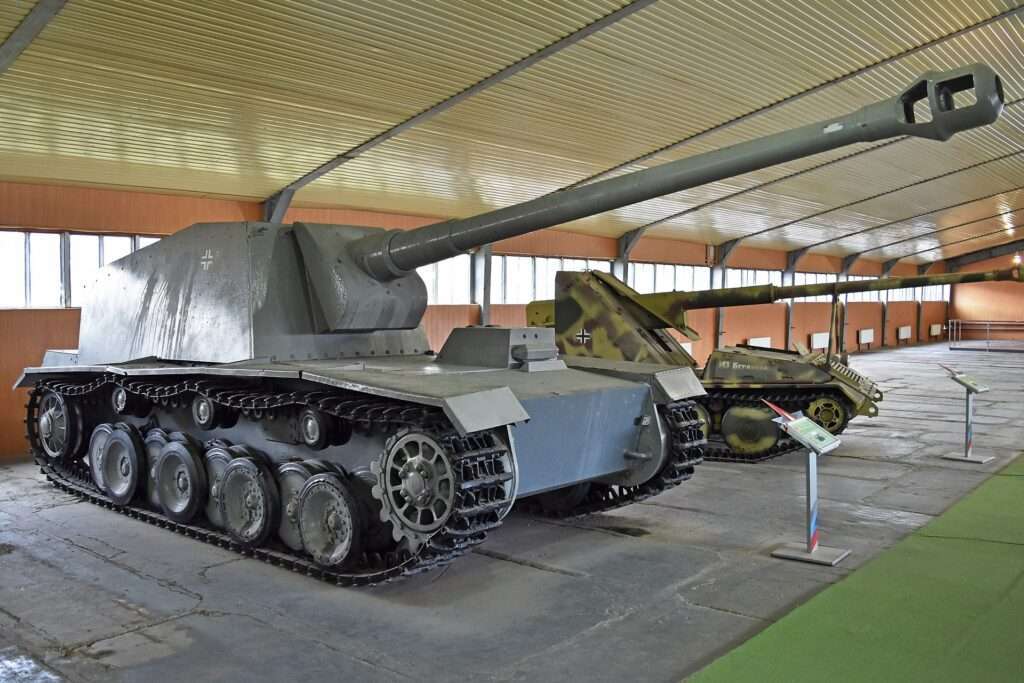
Sturer Emil – A Prototype that Actually Fought in Battle
The Sturer Emil was a WWII German prototype that had a much more interesting career than one would have expected for an experimental vehicle. Unlike most prototypes, the Sturer Emil was actually sent to the frontlines to fight, something it did with impressive success.
Just two examples were made, both armed with powerful 128 mm guns and both renowned for their unreliability. In fact, the nickname Sturer Emil, meaning “Stubborn Emil”, was inspired by the machine’s difficult nature.
Officially designated the Panzer Selbstfahrlafette V (Pz.Sfl. V), these vehicles fared well on the Eastern Front and racked up a large tally of kills.
Despite this, the two vehicles were out of action by January 1943, falling into the hands of the Soviets.
Prototypes
The basis of the Sturer Emil started in the 1930s when Germany desired a vehicle that could attack fortifications from outside their effective firing ranges.
In 1938 work started on an early interpretation of this request: a self-propelled gun (SPG) with a 105 mm K18 gun on the chassis of a Panzer IV.
This resulted in the Pz.Sfl.IVa – better known as the Dicker Max – of which two were built. While this vehicle was promising, the Germans feared that the 105 mm gun would not be enough to deal with the toughest bunkers.
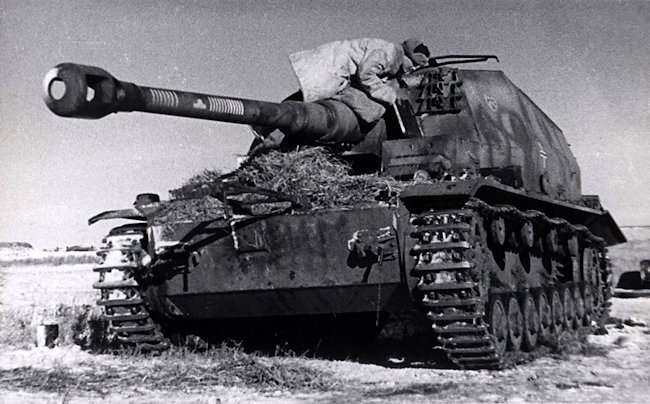 The Dicker Max was eventually sent to the front. Only two were built.
The Dicker Max was eventually sent to the front. Only two were built.
Following this realisation it was decided that a bigger gun was needed. A monstrous 128 mm was selected.
This gun – the 12.8 cm Kanone L/61 – was a vehicle-mounted derivative of the extremely powerful 128 mm Flak 40 anti-aircraft gun.
However as good as the 128 mm gun was at smashing through concrete, it was far too big and heavy to be mounted on the chassis of a Panzer IV.
The only other chassis in development at the time that could possibly accommodate this gun was that of the VK 30.01. This was a prototype heavy tank that was never accepted into service but was important in the development of the Tiger I.
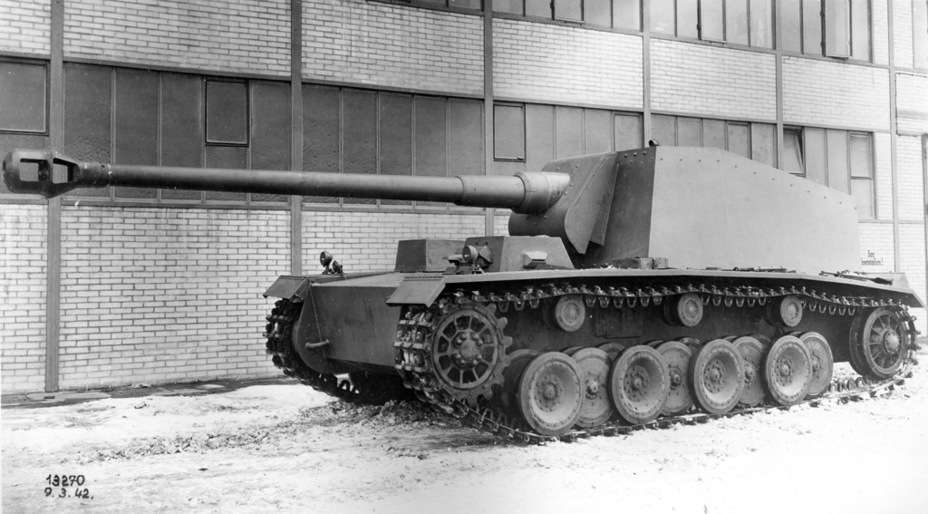 A Sturer Emil shortly after it was built.
A Sturer Emil shortly after it was built.
The name of the proposed SPG was the Pz.Sfl. V.
Set backs with the VK 30.01 meant the Pz.Sfl. V would not be complete until March 1942. This was years after the Germans had captured the Maginot Line – one of the main reasons the SPG was needed in the first place.
The VK 30.01 was cancelled in January 1942, which, combined with the fact the SPG was no longer required, effectively ended the Pz.Sfl. V project.
Still, two VK 30.01 hulls were used to complete two Pz.Sfl. Vs armed with the 128 mm gun.
The Sturer Emil
To create the Pz.Sfl. V, the VK 30.01 hulls had to be extended by 1.5 meters, thus requiring an extra pair of road wheels on each side.
The escape hatches in the sides of the VK 30.01 were retained, but the right one was unintentionally blocked off by a fuel tank.
At the rear of the vehicle was a large, thinly armored, open topped superstructure that housed the 128 mm gun and five crew. The crew consisted of a driver, gunner, commander, loader and radio operator.
Armor protection was 50 mm at most.
Under the gun was a Maybach HL116, an 11.6 litre six cylinder engine that produced about 300 hp. This was not sufficient for the 39 ton Sturer Emil, so the tank had a top speed if just 16 mph.
The gun was the most striking feature of the design, and was a truly devastating piece of weaponry. It could traverse 7 degrees to the right and 5 degrees to the left. Interestingly, the gun can depress 15 degrees, which was basically as low as the gun could go before it hit the front of the hull.
In fact this gun depression was so extreme that the engine could be serviced without the weapon’s removal.
 The Sturer Emil’s extreme -15 degree gun depression.
The Sturer Emil’s extreme -15 degree gun depression.
It did however take up lots of room inside the Pz.Sfl. V and threw up a huge dust cloud upon firing.
Despite being the result of a cancelled project, the two vehicles performed admirably on trials and were actually sent to the frontlines on the Eastern Front to deal with the Soviet’s heavy armor.
The Pz.Sfl. Vs were nicknamed Max and Moritz.
Impressive Service
Repurposed into tank destroyers, Max and Moritz arrived on the Eastern Front in Spring 1941.
During their time in combat the Pz.Sfl. Vs became known as the “Sturer Emil”, meaning “Stubborn Emil”. This was likely because of the vehicles’ slow speed and many mechanical issues.
Max suffered from poor reliability, leaving much of the tank destroying to Moritz.
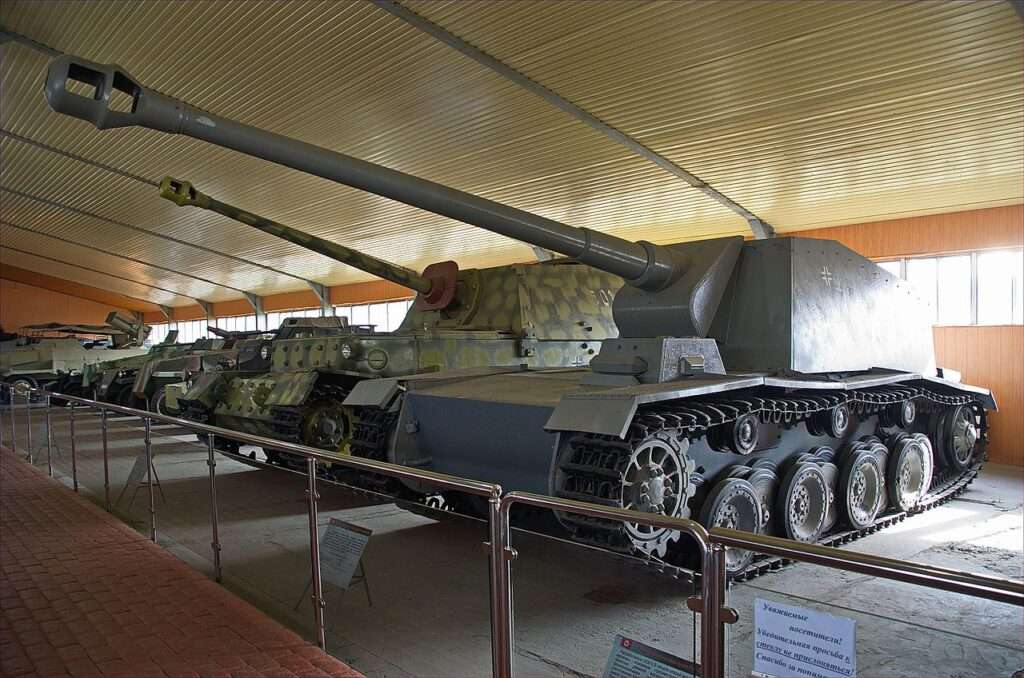 Of the two made, one was destroyed in combat sometime in 1942. Image by Uwe Brodrecht CC BY-SA 2.0
Of the two made, one was destroyed in combat sometime in 1942. Image by Uwe Brodrecht CC BY-SA 2.0
By the following year the vehicles had proved the terrifying power of their 128 mm guns. Shots were often made from long ranges and were able to knock out the heaviest of Soviet tanks.
On one occasion, a round from their 128 mm guns knocked out a KV-1 from a mile away.
Sadly, Sturer Emil Max was destroyed sometime before the winter of 1942 and lost.
Moritz continued on until January 1943, where it was captured north of Stalingrad by the Soviets. This particular vehicle had clearly done well as there are photographs showing it with over 20 kill marks on the barrel.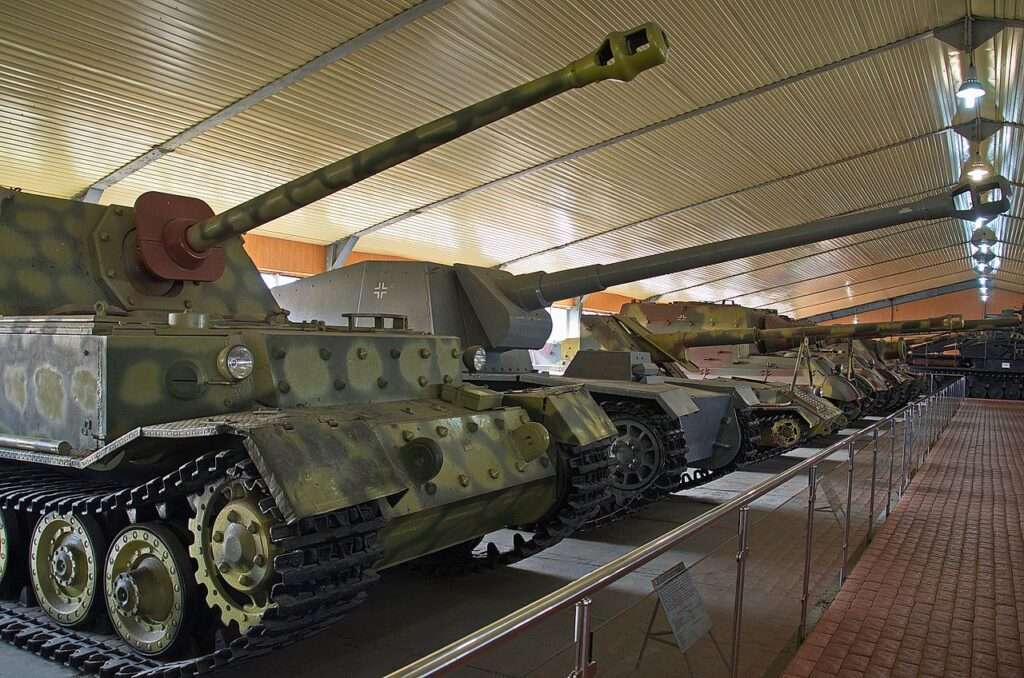 The single surviving Sturer Emil at the Kubinka tank museum. Image by Uwe Brodrecht CC BY-SA 2.0.
The single surviving Sturer Emil at the Kubinka tank museum. Image by Uwe Brodrecht CC BY-SA 2.0.
After its discovery the Soviets transported the Sturer Emil to the proving ground at Kubinka, but testing could not be conducted due to a lack of parts and ammunitio
News
The Hanging Temple: China’s 1,500-Year-Old Cliffside Marvel of Faith and Engineering
The Hanging Temple: China’s 1,500-Year-Old Cliffside Marvel of Faith and Engineering Perched precariously on the cliffs of Mount Heng in Shanxi Province, China, the Hanging Temple, also known as Xuankong Temple, Hengshan Hanging Temple, or Hanging Monastery, is an architectural…
The Willendorf Venus: A 30,000-Year-Old Masterpiece Reveals Astonishing Secrets
The Willendorf Venus: A 30,000-Year-Old Masterpiece Reveals Astonishing Secrets The “Willendorf Venus” stands as one of the most revered archaeological treasures from the Upper Paleolithic era. Discovered in 1908 by scientist Johann Veran near Willendorf, Austria, this small yet profound…
Unveiling the Maya: Hallucinogens and Rituals Beneath the Yucatán Ball Courts
Unveiling the Maya: Hallucinogens and Rituals Beneath the Yucatán Ball Courts New archaeological research has uncovered intriguing insights into the ritual practices of the ancient Maya civilization. The focus of this study is a ceremonial offering found beneath the sediment…
Uncovering the Oldest Agricultural Machine: The Threshing Sledge’s Neolithic Origins
Uncovering the Oldest Agricultural Machine: The Threshing Sledge’s Neolithic Origins The history of agricultural innovation is a fascinating journey that spans thousands of years, and one of the earliest known agricultural machines is the threshing sledge. Recently, a groundbreaking study…
Nara’s Ancient Sword: A 1,600-Year-Old Protector Against Evil Spirits
Nara’s Ancient Sword: A 1,600-Year-Old Protector Against Evil Spirits In a remarkable discovery that has captured the attention of archaeologists and historians alike, a 7.5-foot-long iron sword was unearthed from a 1,600-year-old burial mound in Nara, Japan. This oversized weapon,…
The Inflatable Plane, Dropped Behind the Lines for Downed Pilots
Experimental The Inflatable Plane, Dropped Behind the Lines for Downed Pilots The Inflatoplane from Goodyear was an unconventional aircraft developed by the Goodyear Aircraft Company, a branch of the renowned Goodyear Tire and Rubber Company, also famed for the Goodyear…
End of content
No more pages to load











